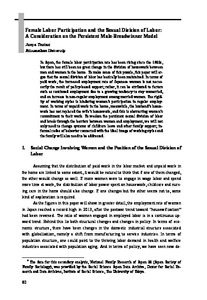Female labor participation and the sexual division of labor: a consideration on the persistent male-breadwinner model

2016
13
3
Summer
80-100
employment ; labour force participation ; sexual division of labour ; social change ; women workers
Gender equality & Women
English
Bibliogr.
"In Japan, the female labor participation rate has been rising since the 1980s, but there has still been no great change in the division of housework between men and women in the home. To make sense of this puzzle, this paper will argue that the sexual division of labor has basically been maintained. In terms of paid work, the increased employment rate of Japanese women is not necessarily the result of policy-based support; rather, it can be attributed to factors such as continued employment due to a growing tendency to stay unmarried, and an increase in non-regular employment among married women. The rigidity of working styles is hindering women's participation in regular employment. In terms of unpaid work in the home, meanwhile, the husband's housework has not replaced the wife's housework, and this is obstructing women's commitment to their work. To weaken the persistent sexual division of labor and break through the barriers between women and employment, we will not only need to change systems of childcare leave and other family support; informal codes of behavior connected with the ideal image of working styles and the family will also need to be addressed."
Digital
The ETUI is co-funded by the European Union. Views and opinions expressed are however those of the author(s) only and do not necessarily reflect those of the European Union or the ETUI.